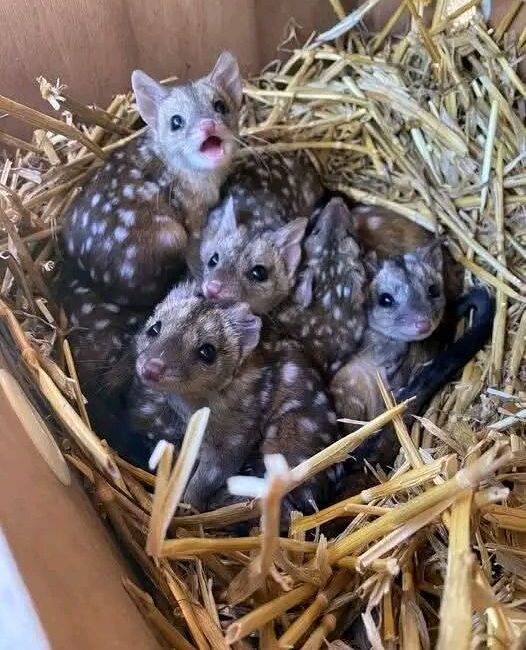Introduction: A Remarkable Moment of Discovery in the Heart of Australia
In the remote expanses of Western Australia lies the Mt Gibson Nature Sanctuary — a haven meticulously managed by conservationists dedicated to reversing the decline of some of the continent’s most vulnerable species. It was here that a team of researchers recently uncovered something truly extraordinary: a litter of baby Western Quolls, a rare carnivorous marsupial species once on the edge of extinction. The sight of these tiny, vulnerable creatures nestled in their den left the scientists profoundly speechless, not only because of their beauty but because it symbolized hope, resilience, and the triumph of dedicated conservation efforts.
This article delves into the full story behind this amazing discovery, exploring the biology and ecology of the Western Quoll, its troubled history and threats, the painstaking conservation programs that made this possible, and the broader implications for biodiversity and environmental stewardship in Australia and beyond. By the end, readers will understand why this momentous event resonates far beyond the boundaries of the Mt Gibson Sanctuary and represents a beacon of hope for species preservation worldwide.
Part 1: Understanding the Western Quoll — Biology, Behavior, and Ecological Role
1.1 Taxonomy and Physical Description
The Western Quoll (Dasyurus geoffroii), also affectionately known as the chuditch, belongs to the family Dasyuridae, which includes other carnivorous marsupials like the Tasmanian devil and various smaller quoll species. The Western Quoll is notable for its medium size, ranging from 700 grams to 1.6 kilograms, with a lithe body length between 35 and 45 centimeters and a bushy tail adding an additional 25 to 30 centimeters.
Its fur is a distinctive reddish-brown or tawny color, marked with an array of white spots that create a pattern unique to each individual — much like a fingerprint. These markings provide excellent camouflage amid the dappled light of their forested or scrubland habitats.
1.2 Habitat and Distribution
Historically, the Western Quoll ranged extensively across the southern regions of Australia, thriving in diverse environments from dense forests to semi-arid woodlands. Today, however, their range is severely limited, largely restricted to isolated regions in Western Australia due to habitat loss and other pressures.
The Mt Gibson Sanctuary offers a carefully managed habitat of native bushland that mimics the quolls’ natural environment, providing shelter, ample prey, and freedom from invasive predators.
1.3 Diet and Predatory Behavior
The Western Quoll is a nocturnal hunter and opportunistic carnivore. Its diet includes insects, small mammals, reptiles, birds, and amphibians. As mesopredators, quolls play an essential role in controlling populations of prey species that might otherwise become pests or damage native vegetation. Their hunting strategy involves stealth, agility, and acute senses of smell and hearing.
1.4 Reproduction and Life Cycle
Breeding usually occurs once a year. Females give birth to litters of up to six or seven young, called joeys, which then crawl into their mother’s pouch to continue development for several weeks. After leaving the pouch, the joeys stay in the den under the mother’s care for some time before becoming independent.
Survival of these young is crucial to the species’ recovery, making the recent discovery of a litter in the wild at Mt Gibson a vital indicator of progress.
Part 2: The Crisis — Decline, Threats, and Extinction Risk
2.1 Historical Decline of the Western Quoll
The Western Quoll has experienced a steep population decline over the last century. Once common throughout much of southern Australia, their numbers plummeted due to a combination of human-driven factors, reducing their population to just a fraction of its former size.
2.2 Major Threats
2.2.1 Introduced Predators
One of the greatest threats facing Western Quolls is predation and competition from introduced species — particularly feral cats and red foxes. These predators were introduced to Australia in the 19th century and have wreaked havoc on native wildlife due to the lack of evolved defenses in endemic species.
Feral cats hunt quolls directly and outcompete them for food resources, while foxes are formidable predators that also prey on young quolls. This dual pressure has been a key driver of the species’ decline.
2.2.2 Habitat Destruction and Fragmentation
Land clearing for agriculture, urban development, mining, and infrastructure expansion has destroyed or fragmented quoll habitat. Fragmentation isolates populations, reduces genetic diversity, and limits access to food and mates.
2.2.3 Other Challenges
Quolls also face risks from disease, road mortality, and climate change effects like altered rainfall and temperature patterns impacting habitat quality and prey availability.
Part 3: Conservation in Action — Mt Gibson Sanctuary and Reintroduction Efforts
3.1 The Australian Wildlife Conservancy’s Role
The Australian Wildlife Conservancy (AWC) is a leading non-profit organization that manages nature reserves and implements innovative conservation programs across Australia. The Mt Gibson Nature Sanctuary, located in a biodiversity hotspot, is one such reserve where endangered species can be protected and reintroduced.
3.2 Designing the Sanctuary
Mt Gibson spans 32,000 hectares and has been restored to recreate natural habitats free from invasive species. Predator-proof fencing, intensive feral animal control, and habitat rehabilitation are core components.
3.3 The Reintroduction Program
The program involved:
- Capturing healthy Western Quolls from stable populations for release.
- Intensive health checks and acclimatization.
- Radio-collaring released individuals for ongoing monitoring.
- Habitat management to ensure adequate prey availability.
3.4 Monitoring and Early Success
The released quolls, including the standout male named Aang, have shown remarkable adaptability. Aang’s behavior in retrieving bait from monitoring devices highlighted their learning capacity and comfort in the new environment — promising signs for survival and reproduction.
Part 4: The Discovery of the Baby Quolls — A Triumph of Conservation Biology
4.1 The Moment of Discovery
During routine monitoring, researchers detected signs of breeding: a nest containing several tiny joeys, barely visible but unmistakably Western Quolls. This event was the first confirmed wild birth in the sanctuary since the reintroduction began — a watershed moment.
Click page 2 for more




